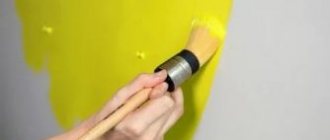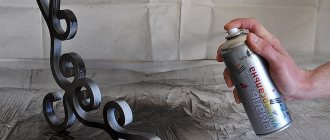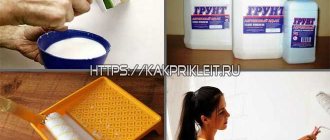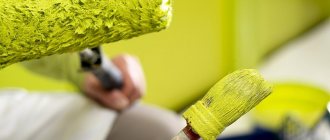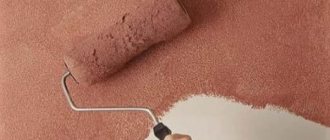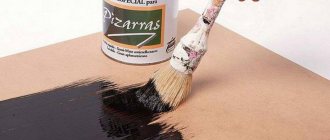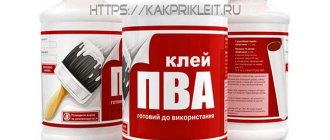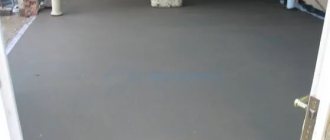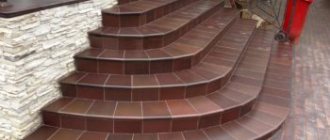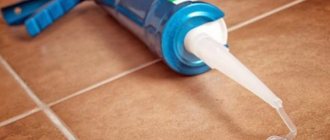Enamel is a substance from the category of paint and varnish products, which, after application and hardening, acquires a glossy surface. The product can be used for finishing premises, cars, in industry, in the production sector and so on.
But in the process of using a coating previously painted with nitro enamel, areas of abrasion and damage to the material may occur, which is why there is a need for additional restoration.
Many people are interested in the question: is it allowed to paint over nitro enamel using acrylic paint? Consideration of details is an opportunity to avoid errors and inconveniences of subsequent use, which is why special attention to the main parameters is required.
Are there “universal” paints with the same surface drying time?
The answer is clear - no. Universality is just a myth used by unscrupulous manufacturers solely for advertising purposes. At best, you buy paint with a one-time or very short-term effect. Therefore, you should not believe the manufacturer’s promises that the paint is equally ideal for repairing the paint surface of a car, for heating radiators, and for decorating a kitchen or bedroom. An excellent result will only be achieved if the paint is used for a specific purpose. In other cases, you will get a mediocre result and simply throw money away.
Often, when choosing, the decisive question is how long the paint takes to dry. This is objectively and directly related to its composition and the environmental conditions in which drying should occur. Why is it important? The pace of paint and varnish work has a direct impact on the overall speed of repair. For example, it is not recommended to carry out any other finishing work while the paint is drying. Otherwise, dust and other construction debris will simply stick to the painted surface.
Is it possible to paint with alkyd paint over oil paint?
Often windows, radiators, ceilings and walls are painted with oil-based compounds. However, modern technologies have made it possible to create more advanced types of paints, for this reason many want to replace the material. Alkyd enamel has many advantages.
If an alkyd resin-based paint is chosen to repaint the paint, then the old oil-based coating must be removed. Only if the previous finish is securely fixed can re-painting be allowed.
Then the wall is sanded, the remaining dust and dirt after the process is washed off with an aqueous solution with soda. After the base has dried, the finished solution can be applied; several layers will be required, it is important that each of them is completely dry.
If an alkyd resin-based paint is chosen to repaint the paint, then the old oil-based coating must be removed.
How long does oil paint take to dry?
Oil-based paints traditionally take the longest to dry. In recent years, manufacturers have abandoned the use of natural drying oil for such compositions. Now in the mass production of oil paints, alkyd or pentaphthalic bases are used. This reduced the drying time of oil paints to one day.
Complete hardening of one layer occurs only as a result of oxidation of the upper oil layer. Factors that matter here include:
- air temperature;
- humidity;
- presence of direct sunlight.
Oil paints with the addition of antiseptic compounds take longer to dry. The period of time sufficient for drying of such and similar paints is indicated to the manufacturers on the can. In any case, drying time is at least 12 hours.
Enamels and nitro paints
For most of these compositions, coating with a second layer is allowed within 20-30 minutes after applying the first layer. It takes about the same time for the second layer to dry. Manufacturers allow up to 12 hours for complete hardening so that painted products can be used.
Please note that nitro-based paints dry faster than enamels. This is also due to the primary areas of use of nitro paints and enamels. The former are mostly intended for painting metal and plastic surfaces (provided that the solvent in the paint base does not “eat” the plastic). Enamels can be used to cover any surface, including wood.
Sergey Yurievich
Construction of houses, extensions, terraces and verandas.
Ask a Question
For PF 115 enamel, for example, the drying time is directly related to the thickness of the layer applied during painting and the color of the paint. For example, it will take 48 hours for cherry and red enamel to dry. For everyone else, 24 hours is enough.
Beauty, and that's all. "Metallics" and "pearl"
The next step in the evolution of coatings is associated with the emergence of “spectacular” coatings.
Back in the era of alkyd, paint and varnish developers came up with the idea of adding tiny particles of aluminum powder to the enamel, which, like micro-mirrors, would reflect the light falling on them and give the coating a sparkling, “metallic” effect.
But the first “metallics” did not gain widespread popularity. These were very short-lived coatings, since aluminum flakes added to alkyd enamel caused rapid fading and clouding of the enamel.
And the spectacular capabilities of the first generation metallics left much to be desired. Since it was a single-layer (single-stage) system, it was impossible to achieve any impressive visual effects. Such “metallics” can be found, for example, on old bicycle frames. You can only see metal inclusions there under a magnifying glass.
And then paint and varnish manufacturers took a different route: they created a two-layer system “base enamel + clear varnish”.
Basic enamels are characterized by the fact that they contain a lot of solvent and dry quickly, but on their own, without varnish, they look rather poor, and their resistance to external influences is poor. But as soon as you apply the varnish, a wonderful metamorphosis immediately occurs: the coating “comes to life” and becomes fabulously beautiful, color saturation and depth appear.
Two-layer coatings turned out to be not only more beautiful, but also more durable and stronger. The colored layer is located under a durable varnish shell, which reliably protects the coating from aggressive external influences, especially from sunlight (a merciless destroyer of polymers).
From a chemical point of view, transparent varnishes are similar to the acrylic paints and varnishes described above, with the obvious difference being the absence of color pigments. Varnishes can be not only glossy, but also matte. And there is even an adjustable shine.
As for base enamels, they can be produced in different ways. A common option is a combination of polyester, cellulose acetobutyrate (reminiscent of NC, only UV-resistant unlike nitrocellulose) and melamine-formaldehyde resin (reminiscent of ML-ku).
At first, only aluminum was added to base enamels, but in the late 80s, particles of processed mica began to be used as effect pigments. This is how paints with the “pearl” effect appeared - similar to “metallic”, but with a more delicate, calm shine. Unlike flat aluminum particles, which reflect sunlight at a certain angle, “pearl” particles scatter the incident light, which gives the effect of a noble, “matte” shine.
Improvement of the effective capabilities of paintwork continues constantly. If earlier metallics with fashionable names “wet asphalt” or “champagne splashes” were a luxury item, today the market offers three-layer “mother of pearls”, “xyrallics”, and “chameleons”. And what will happen next is completely unknown.
How long does it take for water-based emulsions to dry?
Water is considered the most environmentally friendly solvent for paints. Water-based emulsions, called water-dispersion paints, are used to paint almost any indoor surface.
For primary polymerization, 2-3 hours are enough. Complete drying within 24 hours. Some manufacturers produce water-dispersion paints with a complete drying time reduced to 12 hours. It is important that in conditions of high humidity, the drying time of water-based paints is practically unlimited.
Pay attention to the need for preliminary surface preparation for applying water-based emulsions. Otherwise, the dye layer may be completely absorbed into the surface being painted, leaving no traces of color on it or leaving only uneven stains.
Interestingly, water-based paint on the ceiling dries faster than on the walls. This is due to the fact that warm air currents always rise to the top, creating more favorable conditions for paint drying. But it takes at least 24 hours for complete drying.
Does the release form and method of application to the surface matter for paint drying?
The correct answer is yes. Paints in spray cans (aerosol) dry faster if they are applied to the surface in a thin layer.
Surfaces with a high level of porosity, for example, cement-sand plasters, also deserve special attention. Outwardly, it may seem that the paint on them has dried, but in fact it is far from dry. If painting is done on lime plaster, the consequences may be even worse due to the chemical reaction of lime with the paint base.
Stages of painting a wooden base
- Having chosen a paint, pay sufficient attention to preparing the base. If the old varnish crumbles and peels off, the problem areas must be cleaned down to the wood. It is enough to sand the rest of the surface until a matte texture is obtained, then remove the dust with a vacuum cleaner and degrease it with the composition recommended in the instructions for use of the paint.
- The texture of an alkyd varnish coating can be spoiled by unprofessional application of several layers of varnish. The defect is difficult to correct, but necessary. To remove several layers of varnish, use a hair dryer and a spatula. The mass of varnish heated by hot air is easily removed by its working edge.
Note!
A primer will help improve the adhesion of paint to the varnish base - this is the name of a special primer that is applied to the wood in two layers. For varnish coating, a one-time treatment will be sufficient. There are many types of primer, so look for a solution recommended by the paint manufacturer.
- Apply the first layer of paint of the main shade. Most often, lacquered furniture has a deep brown color, so the base layer, through which dark wood is visible, should be light.
- After the first layer has dried, apply the next layer of the main color.
- Next, we paint the furniture facades with a contrasting shade. In this case it will be coral.
- After the paint has dried, the entire surface along the borders is sealed with special masking tape. The borders are spray painted with a different shade.
- The corners are sealed with overlapping masking tape, which is best cut into the required fragments with scissors.
- Now you can paint the borders with spray paint and remove the tape.
- The handles and key to the cabinets are painted gold to match the borders.
Hammer paint
Initially, this type of paint and varnish materials (LPMs) was used exclusively for application to industrial equipment. This type of dye received its name - hammer - due to the external similarity of the texture to the surface after hand-chasing with a hammer.
The composition is based on acrylic, alkyd-styrene or epoxy fillers. Additives include fine glass and aluminum powder. Due to them, particularly high strength of coatings is ensured after drying. It has a characteristic metallic sheen, which is why it is called metallic.
Acrylic car paints
For the base of this type of paintwork materials, manufacturers use acrylic resins of synthetic origin. The advantages of their use are high thermostaticity (up to +180 degrees C) and complete neutrality to alkaline and acidic environments, alcohol and water. They practically do not fade when exposed to direct sunlight.
Ideal for coating metal car bodies, forming a particularly durable polymer film on the surface after drying. When applied to the body, a hardener is added to the base. Hardening of the layer on the surface of the car body occurs within 20 minutes, provided that the painting work is performed in a specially equipped paint booth with a high air temperature inside. But it takes 24 hours to dry completely.
The Montana paint deserves special attention. It takes only 15 minutes to dry on the surface of the car body.
Acrylic revolution
Our painters first became acquainted with acrylic coatings in the early nineties, although in other countries acrylic had probably been used for 30 years at that time.
Let's try to figure out why acrylic is so revolutionary. First, let's take a look at the containers in which these paints and varnishes are sold.
Unlike the enamels discussed above, here we see in front of us not one, but two cans: in one there is a base, in the other there is a hardener.
The components of acrylic coatings, unlike melamine-alkyd ones, cannot be stored in one container, since they will immediately react. Therefore, these products are supplied in two packages, the contents of which are mixed immediately before use. These are two-component materials (2K).
Let's say we mixed the components and applied acrylic enamel or varnish. To understand how curing occurs, we need to take a closer look at each of the components.
The first component contains a solution of acrylic copolymer. This is a high-molecular substance, a product of co-polymerization of acrylic monomers - acrylic and methacrylic acids and their esters. It is important for us now to understand that this copolymer contains units with hydroxyl OH groups. Remember.
Now about the second component - the hardener. It contains a polyisocyanate containing isocyanate groups -N=C=O. These are highly reactive compounds; they easily react with hydroxyl groups OH. This process underlies the curing of acrylic materials: when the copolymer solution and the hardener are mixed, the hydroxyl and isocyanate groups react according to the following scheme:
From the diagram we see that as a result of the reaction, a urethane bond is formed (the structure to the right of the arrow). And due to the fact that the isocyanate groups have the form of three-rayed stars (conditionally), the polymer, again, turns out to be “spatially cross-linked”.
Isocyanate groups can be conventionally depicted as three-rayed stars
Thus, when the acrylic film cures, polyurethane is formed (therefore, such enamels are also called polyurethane or acrylic-urethane). It is polyurethane that provides the coating with those excellent visual and consumer properties for which acrylic materials are famous.
The described mechanism is the main difference between acrylic coatings and enamels of previous generations. We can say that now the curing of paintwork materials has become a controlled chemical reaction, thanks to which painters are no longer dependent on many random factors.
The most important advantage of this method in practice was a significant reduction in the time for complete curing of paintwork materials. Thus, at an air temperature of 20 ° C and normal humidity, all irreversible changes in the acrylic coating are completed in 16-18 hours, and within a few more days the paintwork acquires maximum hardness. At a temperature of 60 °C, the coating completely polymerizes in 40-60 minutes, after which the car will be completely ready for polishing.
Two-component acrylic-urethane enamels with a physical and chemical curing mechanism are a step forward from nitro paints and alkyds. These materials allow you to obtain better coating quality and simplify the technological cycle
The finished film of acrylic enamel has high hardness (close to the hardness of glass), lasting gloss, excellent elasticity and wear resistance. Acrylics are resistant to acids, alkalis and solvents, have excellent adhesion to a wide variety of surfaces, and withstand exposure to sunlight and precipitation.
The advent of acrylic paints and varnishes opened a new era in body repair, making it possible, even in garage conditions, to create a coating comparable in quality to the factory one. This is why everyone loves acrylic.
How long does it take for floor paint to dry?
If you are going to paint the floor, quick-drying acrylic enamels are perfect. In just a few hours you can begin to use the room, however, to ensure complete drying, it is recommended not to subject the floor surface to mechanical stress for at least 12 hours.
If you used oil paints the old-fashioned way, you need to check the drying time on the paint cans. Let us remind you once again that different manufacturers indicate different drying periods, this depends on the composition of the paint itself and some environmental factors.
When using PF 266 paint for the floor, application should be carried out only on dry, primed surfaces. The drying time of the first layer is at least 24 hours, after which the second layer can be applied. Complete drying of each layer – 24 hours.
Is it possible to paint with acrylic paint over oil paint?
The question of whether it is possible to paint with acrylic paint over oil paint can be answered in the affirmative. But a special type must be used - Master 121 paint. Taking into account that the surface has no flaws, the layer does not peel off or crack, only such a wall can be re-painted.
Master 121 is an acrylic enamel that is distinguished by its high adhesion to any type of substrate; it can even be applied to a glossy surface. This product will help to obtain a reliable and strong adhesion of the product to oil-type acrylic. But even the quality of good adhesion requires preliminary preparation of the base:
- First of all, the surface is sanded; fine-grained sandpaper is used for this purpose.
- The wall is washed, all dirt and grease should be removed.
- The surface must dry completely before painting; after the required time has passed, the wall is painted.
To improve the result, an equal amount of water should be added to the paintwork material; applying a more liquid product will make it easier to obtain an even and uniform distribution of the composition.
If you intend to distribute paint over the wall with a spray bottle, then you need to dilute it with special solvents.
Master 121 is an acrylic enamel that is distinguished by its high adhesion to any type of substrate.
Silicone paint and drying time
The drying time for silicone paint at home is from several hours to several days. This process is influenced by a number of environmental factors - primarily humidity and air temperature,
If you dry products in a special chamber, during the first hour the air temperature should be raised to 100 degrees, and during the second hour - to 200 degrees. For complete drying in such conditions, 2 hours are enough.
You can ask your question to our author:
